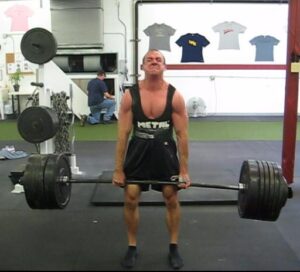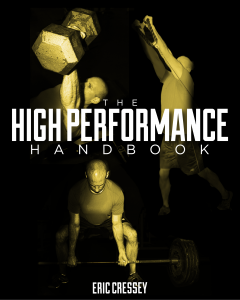How to Deadlift: Which Variation is Right for You? – Part 1 (Conventional Deadlift)
It’s no secret that I’m a big fan of the deadlift.
It’s a great strength exercise for the posterior chain with excellent carryover to real life – whether we’re talking about athletics or picking up bags of groceries.
It’s among the best muscle mass builders of all time because it involves a ton of muscle in the posterior chain, upper back, and forearms.
It’s a tremendous corrective exercise; I’m not sure that I have an exercise I like more for correcting bad posture, as this one movement can provide the stiffness needed to minimize anterior pelvic tilt and thoracic kyphosis.

These benefits, of course, are contingent on the fact that one can perform the deadlift correctly to make it safe. And, sadly, the frequency of what I’d consider “safe” deadlifts has diminished greatly as our generation has spent more and more time a) at computers, b) in high-top sneakers with big heel lifts, and c) watering down beginner fitness programs so much that people aren’t taught to deadlift (or do any valuable, compound exercises) when starting a strength training program.
To me, there are two ways to make things “safe.” The first is to teach correct deadlift technique, which I already did with a 9-minute video that is free to anyone who subscribes to my newsletter (if you missed it, you can just opt-in to view it HERE). This video troubleshoots three common variations of the deadlift: conventional, sumo, and trap bar.
The second is to educate lifters on which deadlift versions are the safest versions for different individuals with different injury histories and movement inefficiencies. That’s the focus of today’s piece. We’ll start with the conventional deadlift.
While this version of the deadlift is undoubtedly the “one that started it all,” it’s also the most technically advanced and potentially dangerous of the bunch. Shear stress on the spine is going to be higher on the conventional deadlift than any other variation because the bar is further away from the center of gravity than in any other variation. Additionally, in order to get down to the bar and maintain one’s center of gravity in the right position while maintaining a neutral spine, you’ve got to have excellent ankle, hip, and thoracic spine mobility. Have a look at the video below, and take note of the position of the ankles, hips, and thoracic spine:
You’ll notice that the ankles are slightly dorsiflexed (knees out over toes). If you are crazy restricted in your ankles and can’t sufficiently dorsiflex, two problems arise:
1. You can’t create a “space” to which the bar can be pulled back toward (a lot of the best deadlifters pull the bar back to the shin before breaking the bar from the floor). You can observe this space by drawing a line straight down from the front of the knee to the floor at the 2-second mark of the above video:
2. Those who can’t dorsiflex almost always have hypertonic plantarflexors (calves). These individuals always struggle with proper hip-hinging technique, as they substitute lumbar flexion for hip flexion in order to “counterbalance” things so that they don’t tip over.
You’ll also notice that the hips are flexed to about 90 degrees in my example. I have long arms and legs and a short torso, so I have a bit less hip flexion than someone with shorter arms would need. They would utilize more hip flexion (and potentially dorsiflexion) to be able to get down and grab the bar.
Regardless of one’s body type, you need to be able to sufficiently flex the hips. You’d be amazed at how many people really can’t even flex the hips to 90 degrees without some significant compensation patterns. Instead, they just go to the path of least resistance: lumbar flexion (lower back rounding).
Moving on to the thoracic spine, think about what your body wants to do when the ankles and hips are both flexed: go into the fetal position. The only problem is that the fetal position isn’t exactly optimal for lifting heavy stuff, where we want to maintain a neutral spine. Optimal thoracic spine mobility – particularly into extension – brings our center of gravity back within our base of support and helps ensure that we don’t lose the neutral lumbar spine as soon as external loading (the lift) is introduced.
As you can see, having mobility in these three key areas is essential in order to ensure that the conventional deadlift is both a safe and effective strength exercise in your program. The problem is that in today’s society, not many people have it. So, what do we do with those who simply can’t deadlift effectively from the floor?
We’ve got two options:
1. We can simply elevate the bar slightly (or do rack pulls) to teach proper hip hinging technique in the conventional stance – and train the movement within the limitations of their ankle, hip, and thoracic spine (upper back) mobility.
2. We can simply opt to go with a different deadlift variation. This is something that, for some reason, most previously injured lifters can’t seem to grasp. They have near-debilitating low back injuries that finally become asymptomatic, and they decide to go right back to conventional deadlifts with “light weights.” They still have the same movement impairments and flawed technique, so they build their strength back up, ingraining more and more dysfunction along the way. They’d be better off doing other things – including trap bar and sumo deadlifts – for quite some time before returning to the conventional deadlift.
And, on that note, we’ll examine those two other deadlift variations in parts 2 and 3 of this series. Stay tuned!
To see how all the deadlift variations fit into a comprehensive strength and conditioning program, check out The High Performance Handbook.




